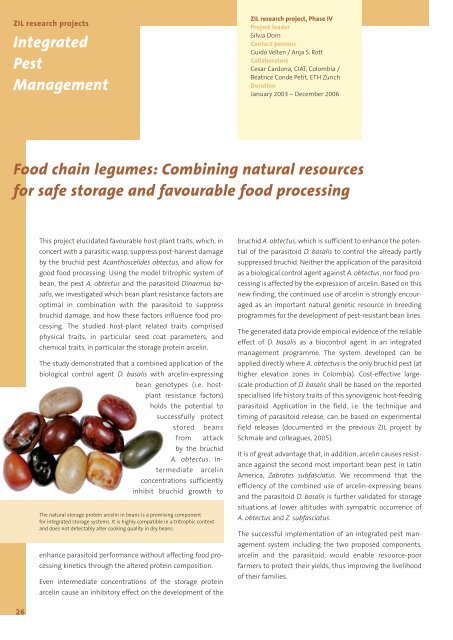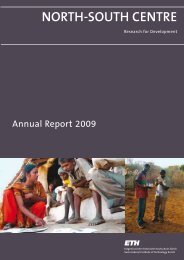Annual Report 2006/07 - ETH - North-South Centre North-South ...
Annual Report 2006/07 - ETH - North-South Centre North-South ...
Annual Report 2006/07 - ETH - North-South Centre North-South ...
Create successful ePaper yourself
Turn your PDF publications into a flip-book with our unique Google optimized e-Paper software.
ZIL research projectsIntegratedPestManagementZIL research project, Phase IVProject leaderSilvia DornContact personsGuido Velten / Anja S. RottCollaboratorsCesar Cardona, CIAT, Colombia /Béatrice Conde Petit, <strong>ETH</strong> ZurichDurationJanuary 2003 – December <strong>2006</strong>Food chain legumes: Combining natural resourcesfor safe storage and favourable food processingThis project elucidated favourable host-plant traits, which, inconcert with a parasitic wasp, suppress post-harvest damageby the bruchid pest Acanthoscelides obtectus, and allow forgood food processing. Using the model tritrophic system ofbean, the pest A. obtectus and the parasitoid Dinarmus basalis,we investigated which bean plant resistance factors areoptimal in combination with the parasitoid to suppressbruchid damage, and how these factors influence food processing.The studied host-plant related traits comprisedphysical traits, in particular seed coat parameters, andchemical traits, in particular the storage protein arcelin.The study demonstrated that a combined application of thebiological control agent D. basalis with arcelin-expressingbean genotypes (i.e. hostplantresistance factors)holds the potential tosuccessfully protectstored beansfrom attackby the bruchidA. obtectus. Intermediatearcelinconcentrations sufficientlyinhibit bruchid growth toThe natural storage protein arcelin in beans is a promising componentfor integrated storage systems. It is highly compatible in a tritrophic contextand does not detectably alter cooking quality in dry beans.enhance parasitoid performance without affecting food processingkinetics through the altered protein composition.Even intermediate concentrations of the storage proteinarcelin cause an inhibitory effect on the development of thebruchid A. obtectus, which is sufficient to enhance the potentialof the parasitoid D. basalis to control the already partlysuppressed bruchid. Neither the application of the parasitoidas a biological control agent against A. obtectus, nor food processingis affected by the expression of arcelin. Based on thisnew finding, the continued use of arcelin is strongly encouragedas an important natural genetic resource in breedingprogrammes for the development of pest-resistant bean lines.The generated data provide empirical evidence of the reliableeffect of D. basalis as a biocontrol agent in an integratedmanagement programme. The system developed can beapplied directly where A. obtectus is the only bruchid pest (athigher elevation zones in Colombia). Cost-effective largescaleproduction of D. basalis shall be based on the reportedspecialised life history traits of this synovigenic host-feedingparasitoid. Application in the field, i.e. the technique andtiming of parasitoid release, can be based on experimentalfield releases (documented in the previous ZIL project bySchmale and colleagues, 2005).It is of great advantage that, in addition, arcelin causes resistanceagainst the second most important bean pest in LatinAmerica, Zabrotes subfasciatus. We recommend that theefficiency of the combined use of arcelin-expressing beansand the parasitoid D. basalis is further validated for storagesituations at lower altitudes with sympatric occurrence ofA. obtectus and Z. subfasciatus.The successful implementation of an integrated pest managementsystem including the two proposed components,arcelin and the parasitoid, would enable resource-poorfarmers to protect their yields, thus improving the livelihoodof their families.26
















